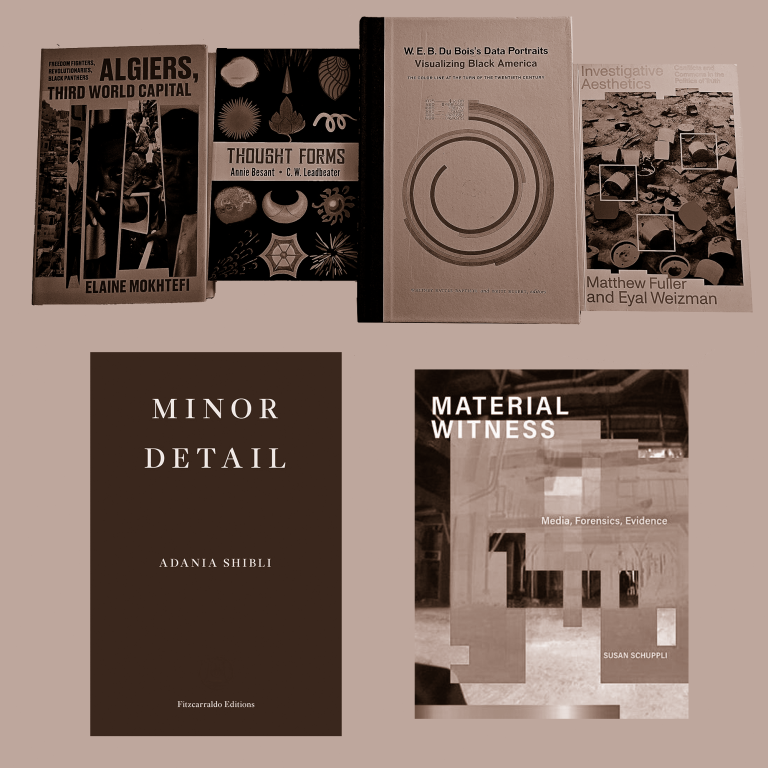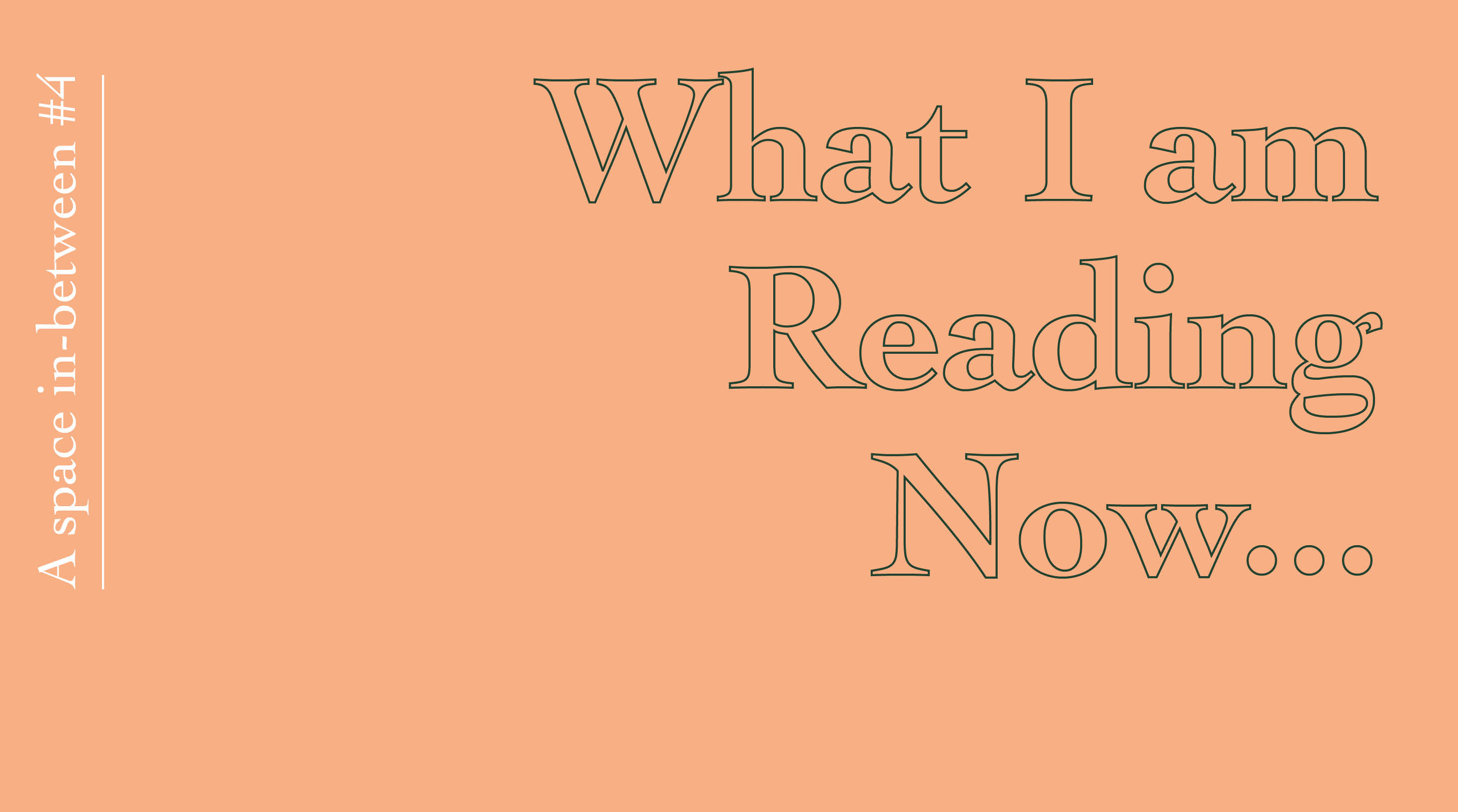What I am Reading Now…
Anjalika Sagar
Speaking from Truth with Power
November 2023
Things go from bad to even worse, my voice is stuck in my throat. It is hard to focus on anything else but the news. One reads the broadsheets and mainstream media; they are decrepit punitive reminders of the mendacious, gabbling opportunism that automates confusion, violence, and muddled opinion. The consequences of this are deadly and weigh heavily.
A studied brutality conceals itself in banality, and is masking itself, amplifying its powers of dominion as it streams into our hands. Anxiously one doom scrolls, interrupted by intravenously loaded preposterous deadening clutter; adverts for menopausal supplements, hip food, cute cats, or frontierist schmutter for gentrifiers, smug designers by the name of Pioneer or Wolf, then non-stick pink pan ads, followed by independent news videos of the murdered and dying posted by those who risk their lives, with eyes that forgot to shut.
It flickers vertically before me. It is an obscene and numbing experience. My eyes are red and dry then fill with tears, my chest is tight, some nights I can’t catch my breath and nausea rises along with dread. But nothing can be as bad as losing everyone and everything you love at once. I want to throw my phone across the room and see it shatter.
The air is already full of messages, it is not so far away, over there you know, we live under the same sky under the same prevailing wind.
I try and read the mood in the streets, at least in my neighbourhood smiles don’t come easy anymore if ever. I am only reading or watching to try and make sense of doing anything at all, and to take the great liberty of sleep.
Is this 1939 or 2023?
Television was my third parent in the 1980s; there I gained a kind of education and created a mind screen. I search and scroll through my inner archive instead of that toxic appendage called a smart phone. No not nostalgia! I am looking for those who spoke and speak truth to power, something immortal, something that can only live on the screen, in music or a book forever, something brave, full of courage, non-conformity. Something that can’t be trashed, erased, or repeated. I need it now.
That night everything on Netflix in November 2023 seemed futile and naff, tedious and cliched. Formats as dull as a Mac Donald’s burger, emotions as wide as a parking lot in somewhere called Generica.
Their cries break my heart, I lose perception of my hands, this is existence between something called life and something called death. An ending, an extinction, a burning.
I am reminded of Robert Bresson and visit again his Procès de Jeanne d’Arc (The Trial of Joan of Arc, 1962)
Bresson writes:
“In my Trial of Joan of Arc, I have tried to avoid “theatre” and “masquerade”, but to arrive at a non-historical truth by using historical words.”
– Robert Bresson
This is one of Bresson’s most ignored films. But 61 years later, and in the context of other adaptations of the trial by Carl T. Dreyer and Jacques Rivette’s La passion de Jeanne d’Arc (1928) and Jeanne la Pucelle II – Les prisons (Joan the Maid: The Prisons, 1994) – Bresson’s film is a spartan minimal experiment with non-professional actors, and it endures. He created the script based on the actual transcript notes of the trial unveiling the precision by which Joan spoke truth to power and the film transmits this as a speech act to the future. She is as a vibratory channel not capturing or speaking from history, but exceeding it with an expressionless, stoic, insurgency, configuring a transhistorical specificity that alludes temporal capture.
Who do you believe are the most courageous people in the world right now?
I am reading.
Annie Besant’s Thoughtforms
She donned a white sari, odd attire for a Victorian woman, with it a weirdly matched ruffled white shirt typical of the times and white sandals. She based her somewhat unique style on the clothing of a Hindu Widow. When asked why she remarked with pious fervour saying, “she was in mourning for the wrong British rule had done to India”. Born in 1847 in London and of Irish origin, she was a ‘headstrong woman’ both a spiritualist, later leader of the theosophical society, a thinker, a writer, and a committed political activist. Besant campaigned actively for women’s liberation in India and in the UK, she also participated in the struggle for Indian ‘home rule’ and launched the Home Rule League in 1916, modelling the Indian struggle on that of Ireland. In the late 1800s she was a member of the Fabian Society, and had a committed and close intellectual and political relationship with the Anglo-Irish playwright and activist George Bernard Shaw. I love this book for many but also personal reasons; Annie Besant had an incredible influence on my grandmother’s life and for a time was her teacher in Adyar in Chennai at the Theosophical Society. But this is a much layered and longer story as one might imagine, so for now, in brief …
My Nani, Anasuya Gyan Chand became president of NFIW (The National Federation of Indian Women) in 1957 which was the women’s wing of the communist party in India and part of the WIDF (The Women’s International Democratic Federation). She travelled the world and with it made correlations between self-determination, particle physics, communism, theosophy, spirituality, and feminism. It is this generational aftermath I live with, attune to in life and from whence I emerge.
Published in 1905, Thoughtform by Annie Besant and the occultist and member of the Theosophical Society Charles Webster Leadbeater, is a mediation on form and thought and is somewhat Tantric in its perception. A book that influenced many a modern and abstract artist. An attempt to study how the aesthetics of the inner and outer worlds might merge as thought but combine haptically, where contours are made sensible in colour and sound. She and Leadbeater visualize their etheric clairvoyant images with vibrant astral colours that emanate as vibrational shapes or modern mandalas that open the senses to cosmic forms, which shape the universe.
Matter and thought merge, the complex forces of mysticism and rationalism take form, sound and seeing fold. Were these ideas callings to the transformative and liberatory power of thinking? This is a book where synaesthesia finds its home or perhaps it is a gift from the ‘anima mundi’.
Not only in the transcendent experience of insight and liberation has the ‘prima materia’ has made itself present. Matter, from a leaf to a tyre to a glacier, all contain the power to witness. As planetary sensing library that records and counters the crimes that these brutal men would like us to forget. Whom might wish that ecologies, humans, histories, families, and memories be erased but they should remember that even the rubble speaks, even the soil is bound by memory and it all can surface eventually as testimony – All matter perhaps is possessed by the spirit of speaking truth to power, and all matter does not remain silent.
Two books I return to where these concepts are most definitively argued are: The artist and theorist Susan Schuppli’s Material Witness from 2020 published by MIT Press and Eyal Weizman and Matthew Fuller’s Investigative Aesthetics: Conflicts and Commons in the Politics of Truth from 2021 published by Verso.
“Aesthetics” writes Eyal Weizman “is effectively the way in which things register the proximity of other things. Deep attunement to objects and surfaces is our starting point…”.
Indeed they continue to clarify a process of sensitisation . ‘Aesthetics’ has its root in the ancient Greek word aisthesis – which was used to denote that which relates to the senses.
“Material Witness introduces a new operative concept” and is an exploration of the evidential role of matter as both recording external events as well as revealing the practices and procedures that enable such matter and material to testify publicly. Organized in the form of a trial the book travels through various cases to expose how this has been deployed. I see this as an ontological transformation in understanding memory, law, and the role of the witness. In a world being hushed by the operational powers and strategies that perpetuate multiple scenes of multiple crimes, a communal counter-formation of justice is the ongoing challenge.
The other books I have started reading are.
Minor Detail – Adania Shibli
Within the first few pages one becomes aware of the power of this novel, where the erasure of the helpless followed by elimination for daring to expose that erasure articulates the studied brutality of this present.
Algiers Third World Capital (2018)
“Elaine Mokhtefi was born in New York. After the Second World War, she joined the youth movement for world peace and justice, becoming director of a militant student organization. In 1951 she settled in France as a translator and interpreter for international organizations in the new post-war world. In 1960, she joined a small team in New York as part of the Algerian National Liberation Front, lobbying the United Nations in support of the government in exile and working for Algerian independence. When the struggle was won, she made Algeria her home, working as a journalist and translator. She married the Algerian writer and liberation war veteran Mokhtar Mokhtefi, who died in 2015. A painter as well as a writer, she lives in New York”.
W.E.B. Du Bois’s Data Portraits. Visualizing Black America
“The famed historian and sociologist W.E.B. DuBois believed that social science data could be visually profound. In the 2018 essay collection W.E.B. Du Bois’s Data Portraits: Visualizing Black America, architecture scholar Mabel O. Wilson describes how Du Bois used infographics and various artistic media to counter assertions by Georg Wilhelm Friedrich Hegel that Africans were “incapable of any development of culture” and that the black experience was characterized by “sensuous arbitrariness.” In the same volume, designer Silas Munro explains just how important the arts were for Du Bois’s scientific argument: “The Du Bois infographics were published twenty years before the founding of Bauhaus,” and their modular style predated “the rise of dominant European avant-garde movements… considered to have their origins in Russian constructivism, De Stijl, and Italian futurism.” Du Bois’s charts are both scientific and evocative. And they are provocative. They draw in viewers to study them, to make new insights, to raise new questions, and to take positive action”.
https://www.dignityanddebt.org/projects/du-boisian-resources/
Anjalika Sagar was born, lives and works in London. She is co-founder of The Otolith Group and founder of Multitudes. She studied social anthropology at the School of Oriental and African Studies at the University of London. Her work includes curatorial projects, essays, films, videos and photographic works. She is interested in the relationships between sound, text and image, archives and the potential legacies of film.
Watching
The Trial of Joan of Arc, Robert Bresson (Artificial Eye, 1962)
Reading
Thoughtforms, Annie Besant (1905)
Material Witness, Susan Schuppli (MIT Press, 2020)
Investigative Aesthetics: Conflicts and Commons in the Politics of Truth, Matthew Fuller and Eyal Weizman (Verso, 2021)
Minor Detail, Adania Shibli (Fitzcarraldo Editions, 2020)
Algiers Third World Capital: Freedom Fighters, Revolutionaries, Black Panthers, Elaine Mokhtefi (Verso, 2018)
W.E.B. Du Bois’s Data Portraits: Visualizing Black America, The W.E.B. Du Bois Center at the University of Massachusetts Amherst (Princeton Architectural Press, 2018)

Please note the views published in What I am Reading Now… are personal reflections of the contributors.
These may not necessarily represent the views of the University of Dundee.
Readers who wish to make a donation to support Medical Aid for Palestinians can do so here.
———
Previous Issue: Kodwo Eshun, October 2023
Next Issue: Maria Chávez, December 2023
